|
|||
|
We are standing at the 3000 foot level on the largest mountain on the globe, by some accounts, though more than half its height is under the ocean. The goal is a one-day sea-to-summit climb of 13,796 foot (above sea level) Mauna Kea, on the big island of Hawaii. Two hours earlier, before dawn, with headlamps reflecting eerily off the hand-hewn walls of an abandoned cut through the coastal cliffs on the northeast side of the island, we picked our way down to Koholalele Landing. It was low tide, and the near-vertical 10 foot drop from the landing to the water was covered with a slippery slime. But our rules were to touch boots in the surf as the official start. Working my way down I almost slip into the crashing surf, but finally just my boots get a good dowsing. Jeff, a better rock climber, and apparently a better slime climber also, negotiates the boot baptism more easily. The start thereby official, we hugged each other good luck and headed up.
Just before 1000 feet, according to my altimeter watch,
I resorted to a bandana in a partially successful
attempt to keep my glasses functional. Not Jeff, though.
This climb, if successful, will complete our father/son project of climbing the highest point in each of the 50 United States. For almost three years we have planned and climbed together, sharing vision, pain, and summit success. I remember as a kid thinking how wonderful and highly improbable it would be just to set foot in each state. Now, with only one state highpoint yet to conquer, that confining childhood image seems quaint and itself improbable. At least Jeff will not - does not - have that particular conceptual prison. What a wonderful time we have had. Only about half a dozen of the 50 highpoints involve serious climbing or mountaineering. Mauna Kea is not one of them, as it has a road to the top (though it is the fifth highest of the state highpoints, topped only by Alaska, California, Colorado, and Washington). As the most fitting finish to a fabulous project we are shunning that easy approach in favor of attempting sea-to-summit in a day. To our knowledge no one has ever done this, and we're not sure exactly what we might have bitten off. This is an elevation gain of almost 14,000 feet, and the most we have done in a single day before had been about 6500 feet. That was on the northwest ridge of Boundary Peak, the highest point in Nevada, and had left us hurting on top and half dead at the end of the day. Looking up at Mauna Kea and thinking of Boundary, I do a quick calculation of what twice half-dead might portend. But our immediate goal is survival of a different kind. The C&H plantations behind us, we enter a ranchland paradise. Now we have to contend, reportedly, with the wild dogs. Whatever awaits us, we hope it doesn't make a commotion at least until we're well above the ranch buildings - so as not to disturb the ranchers at dawn on Sunday morning. We hope to slip silently through without notice. But we hadn't figured on the watch cows. The cattle are up and about, just waiting for this chance, it seems, and they spot us as intruders right away. We would have preferred that they attack us, as we could have handled that (probably). Instead they run scared and that pastoral setting erupts in the most dreadful bovine blaring imaginable. The wild turkeys and pheasants (both imported from Ohio, it seems) chime in and add to the decibels and frequency spectrum of the cacophony. Normally one thrills to the sound of a wild gobble, but now we shudder at the shattering of tranquility.
At 6:04 we nervously skirt a ranch complex, apparently unnoticed, and continue up on a jeep trail. A few hundred vertical feet later, at 4000 feet and above a band of tropical forest, we stop for our second snack, feeling that we probably hadn't disturbed the ranch folks afterall.
Above the tropical forest
5000 feet easily comes and goes. The sun is bright now, and I trade the bandana for a wide-brimmed hat. At 5500 feet, the Mana road, the 4-wheel drive beltline circling the east side of Mauna Kea, bisects this tilted western scene. Later (he spared demoralizing me then) Jeff said that's when he noticed that I was starting to slow down. (Well after all he is three decades younger and in the prime of life.) But I'm feeling strong, and now know that at the very least will set a new personal best for a one-day elevation gain. Cows appear now and then, all strangely silent up here where it doesn't matter, but no dogs. The jeep trail keeps heading in the right direction, steadily up, toward the still distant upper slopes, and relentlessly we keep putting one foot in front of the other. 6000 feet, another snack, then 7000. It's late morning now, and the ever-present temperature inversion that Mauna Kea creates by shooting to such a great height directly out of the sea has begun to trap the day's accumulation of rising water vapor. This inversion forms the barrier cloud that blocks light and air pollution from below and keeps the thin air above 11,000 feet pristine. Because of this, the top of Mauna Kea is widely regarded as one of the best spots on earth for observational astronomy and there are four major telescope complexes near the summit. The road up the other side of the mountain services these telescopes. Slowly the barrier cloud swallows us, and the bowels of this inversion monster steadily get murkier and wetter. At just under 8000 feet the jeep tracks end at a cabin. It's 10am and time for lunch and a rest. There's a lock on the cabin door, but because it's raining we try the door anyway. It's unlocked and opens at a touch. There's a table and benches inside, so we lunch in the dry and savor that new personal best. Moreover, we're about an hour ahead of the target pace of averaging 1000 vertical feet an hour and still feeling good. "Only 6000 more feet to go," I cockily proclaim, "we're going to make it." That blithe pronouncement does not take into adequate account the worsening weather, our steady tiring, and the rapidly thinning air. The worst is yet to come. The "short" lunch break stretches into an hour of luxurious rest. We're both more tired than we had thought, and neither of us is physically anxious to get going. But the sense of challenge and adventure is stronger, and at 11am we step back out into the mist and head up again. We begin to enter our fourth major environment of the day, with lava increasingly replacing the grass. Now there is no trail and visibility is down to several hundred feet. It's map and compass time. I enjoy compass work in a whiteout. You have to take accurate compass bearings from the map and, throwing your natural instincts to the mist, follow these bearings religiously. It can be an enervating head-over-heart game. Both Jeff and I have a decent sense of direction, but we've learned that in whiteouts it's worthless. For example, in a whiteout east of Spruce Knob (the highest point in West Virginia) trusting that great sense of direction had us traveling blind and ultimately heading for Virginia. Finally consulting the compass, its message was hard to believe. But we decided to overrule our "gut feel", turn around, and meekly heed the magnetic arrow's instructions on the way to the summit. Two hours later we were standing on top of the Knob. Lesson learned. Trusting the map and compass would be the thing to do, until we pop above the inversion layer and could again navigate by sight. Jeff took charge (ah, exuberant, wonderful youth). It was beginning to dawn on me that I was slowing down, and was therefore content to leave the leadership to Jeff. (Mind you, I could have blazed the trail.)
Mauna Kea is a huge dormant volcano, but we had not been able to find out beforehand what sort of lava lay in wait above 8000 feet. As the last of the grass and bushes give way we begin skirting clumps of A'A. There are traces of Pu'upu, but nary a sign of Pakoekoe. We are fervently hoping there isn't A'A like that on the upper slopes of neighboring (not so dormant) Mauna Loa. Luck is with us. The gentle slope stays a mixture of hard fist-sized smooth rocks and modest A'A that is thoroughly beaten into submission, probably as a result of countless stompings by the inversion monster. We can't blame our slowing pace on the footing. At 10,000 feet and just before 2pm we pick up Ka'ula Gulch, just like the map and compass predicted and then no longer really need either. Much lower on the mountain this gulch hosts an idylic tropical isle stream. But here it's a dry scar in the lava, serving as an uninspirational guide through the Pu'us in the mist. At 11,000 feet and just after 3pm we pop above the inversion, right on target and only slightly behind schedule. All around us are Pu'us, rising out of the hulk of the mountain like big city skyscrapers. Walking along Ka'ula Gulch looking up and around I feel a bit like a rubber-necked first-time country visitor to New York City walking down Fifth Avenue. (Maybe Jeff's not taking time to sightsee; maybe that's why I can't seem to catch up with him.) Pu'us are satellite volcanic cones, each with a crater in the top. But from where we are the craters aren't apparent and the Pu'us seem more like giant sand piles, 500 feet high. It's not sand, of course, but Pu'upu (aha, a Pu'u is made of Pu'upu); at one time each of these Pu'us was a fireshooter and the cones were made by lava rain. They are all a dull brownish red color, and the one on our left, according to the map, is named Red Hill. We had just executed a near-perfect trajectory between Pu'u Lehu and Pu'u Kanakaleonui in the mist, and emerged next to Red Hill. On our right is Pu'u Hoaka, up ahead are Pu'u Makanaka, Pu'u Ala, Pu'u Poepoe, and other Pu'us. From atop the still distant Pu'u Kea, its crater filled in for the sake of science, the massive Canadian/French/Hawaiian Telescope (CFHT) winks seductively at us. Just an A'A stone's throw away from Pu'u Kea is Pu'u Wekiu, the true summit. It's still four miles away, but, in contrast to the view 9 hours earlier and 8000 feet lower, tantalizingly close.
So we tackle another 1000 foot slice, at that maddeningly slow pace. At 13,000 feet I am really holding Jeff up, and he's anxious to get to the summit (me too, but...). With every step I'm raising that personal best, and possibly accomplishing something significant for my over 50 age group, but that realization somehow seems small consolation at the moment. Finally we reach the base of Pu'u Kea, though not quite at the same time - Jeff has gone on ahead to "look for a ride down". Naturally, looking up at the telescope from that angle that simple little Pu'u never looked so high, nor its Pu'upu sides so steep and unstable. But this is the last hurdle, so we each tackle it with renewed gusto (?), only to find that the frontal assault method is mostly self-defeating. A gentle traversing technique turns out to work better, but it's still a hard, slow, frustrating process. At 7pm I claw my way over the edge and step on top of Pu'u Kea under the shelter of CFHT. Success! How tremendously satisfying it is looking down on all those Pu'u skyscrapers, seeing their craters for the first time. The sun is low in the western sky and each crater casts a surrealistic picture-perfect shadow. This calls for a quick snap-shot or two before hustling out the down jacket and a layer of insulation for under the windshell hat. It's cold, and the wind fierce - it's surely more like Denali (Mount McKinley, Alaska) than the Hawaiian coast we left this morning. But nothing, not even the biting cold, can detract from the sense of total triumph.
I can't tell if the problem is elevation or exhaustion - probably both, with a little dehydration thrown in. The feeling is a bit like on the summit ridge of 20,300 foot Denali a year earlier. There, because of the very thin air, we needed four breaths for every step. But this is only 13,000 feet, not 20,000 feet. We had acclimatized adequately, we thought, sleeping at 6500 feet the two preceding nights and spending most of the two preceding days at 11,000 feet on Mauna Loa. So we shouldn't be suffering from the altitude. And since neither of us have even mild headaches (invariably associated with altitude-related mountain sickness), we conclude that the main factor is not thin air but simply the predictable effects of pushing a body beyond its meager limits. That business over, we still have to make it to the true summit on Pu'u Wekiu. That means dropping down a hundred feet and going back up two hundred. But there's a path, and there is nothing to it. As the sun slips below the horizon, arm in arm we step on the summit and become the first father/son team to climb all 50 state highpoints, and possibly the first father/son team to climb Mauna Kea sea-to-summit in a single day.
Back on Pu'u Kea we had unexpectedly run into Adrian Crane, the first person we've seen all day. Adrian had just come from the summit, which was the 49th highpoint for him. Four days later he completed the 50 on Mt Rainier in Washington and became #14 on the all-time list. For about ten minutes, after Adrian had summited and before Jeff and I did, there were three 49ers in action together on Mauna Kea. Adrian also did sea-to-summit, but in a different way. He bicycled via road the first 9000 feet to Hale Polaku on the south side of Mauna Kea, then walked up the standard trail from there. So there the three of us are in the dark on Pu'u Kea, all bundled up against the cold wind, trading climbing stories and trying to decide where to spend the night. I'm still hurting, and I'm not sure that Jeff feels too chipper, but we decide to expend the effort to get lower and out of the wind. Jeff hadn't been able to scare up a ride, so we start walking (more like stumbling, at least for me) toward Hale Polaku, down the road used to access the telescopes. (Hale Polaku, or HP for short, is headquarters for the visiting astronomers.) The day is finishing the way it started, with headlamps piercing the darkness. But this time we're heading down instead of up. A mile or so down the road a car catches us - a German astronomer on duty making a trip down to HP for something he has forgotten. He gives us a lift, and invites us into the HP commons for a rest and some refreshment. As I'm having a glass of juice, Jeff falls deep asleep on the sofa, from which I have to awaken him a little later so that we can be on our way (camp is not too far away, at 6500 feet). Do you suppose he's not completely invincible after all? |
|||
|
A great finish to a great project. As it turned out another astronomer at HP, bored with sitting around, offered to take us to our camp at 6500'. Shortly after we started out his car engine quit and wouldn't start. We lifted the hood, looked around, saw a dangling wire, and Jeff said "it looks like this wire should plug in there". We plugged it in, the car started, and soon we were sound asleep at our camp. -jlw |
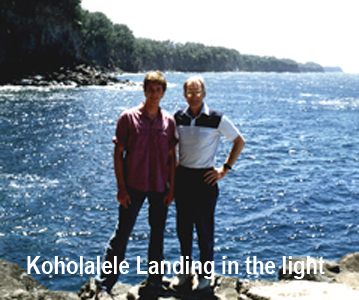 "It sure looks a long way off."
Jeff casually remarks as we break into an open spot and see the first morning sun glint off the upper slopes. The true summit was even further, not yet in sight. "Yeah", I say, "it does", while thinking: the topo map says it's only about 20 horizontal miles away; how can the topo be so wrong? At that moment our self-imposed challenge had never loomed so large.
"It sure looks a long way off."
Jeff casually remarks as we break into an open spot and see the first morning sun glint off the upper slopes. The true summit was even further, not yet in sight. "Yeah", I say, "it does", while thinking: the topo map says it's only about 20 horizontal miles away; how can the topo be so wrong? At that moment our self-imposed challenge had never loomed so large.
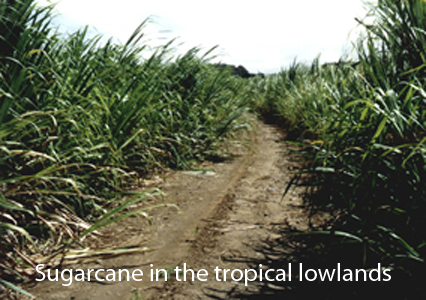 For the next two hours, skirting the 'cane fields by the light of the full moon, we sweated steadily up through lush lowlands that drink in 300 inches of rainfall per year. The tropical rain forest here has long ago succumbed to the American sweet-tooth and C&H sugarcane plantations. Like thieves in the night, we were melting through the muggy darkness, but only to steal what no one else dared want - the chance to test our mettle on the trackless northern slopes of Mauna Kea.
For the next two hours, skirting the 'cane fields by the light of the full moon, we sweated steadily up through lush lowlands that drink in 300 inches of rainfall per year. The tropical rain forest here has long ago succumbed to the American sweet-tooth and C&H sugarcane plantations. Like thieves in the night, we were melting through the muggy darkness, but only to steal what no one else dared want - the chance to test our mettle on the trackless northern slopes of Mauna Kea.
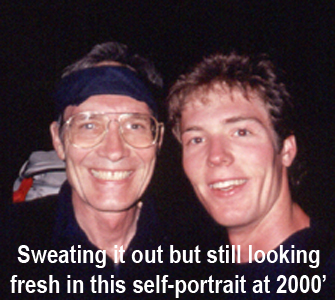 It must be because he has no glasses to steam up and a thick head of hair that serves as a bandana - surely he's sweating as much as me (isn't he?). At 2000 feet we stopped for our first refreshment break, trailmix and gatorade. And now at 3000 feet, with the rising sun, we rise above the 'cane into Hawaiian cattle country and catch that intimidating glimpse of our destination.
It must be because he has no glasses to steam up and a thick head of hair that serves as a bandana - surely he's sweating as much as me (isn't he?). At 2000 feet we stopped for our first refreshment break, trailmix and gatorade. And now at 3000 feet, with the rising sun, we rise above the 'cane into Hawaiian cattle country and catch that intimidating glimpse of our destination.
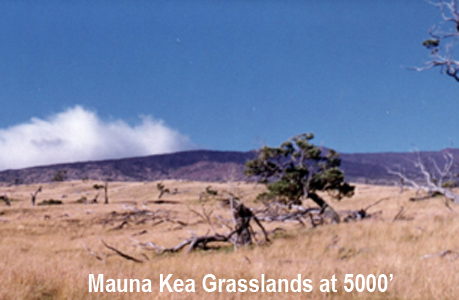 treelike it's a world of tan
pastureland studded with prickly pear cactus -
more reminiscent of the Oklahoma prairie than the Hawaiian palm tree caricature. Endless miles of tilted prairie. It's only 7am, and already we've had three major changes of scene: Hawaiian coast, tropical lowlands, and high dry grassland.
treelike it's a world of tan
pastureland studded with prickly pear cactus -
more reminiscent of the Oklahoma prairie than the Hawaiian palm tree caricature. Endless miles of tilted prairie. It's only 7am, and already we've had three major changes of scene: Hawaiian coast, tropical lowlands, and high dry grassland.
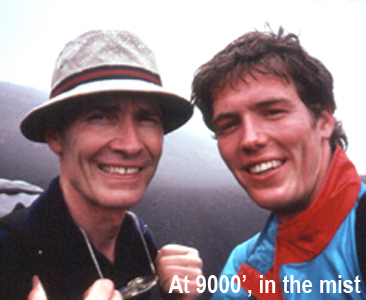 At 9000 feet, with no visibility, no trail, and evidence of A'A mounting, our worst fear (the dog danger being past) seems to be materializing: stranded in endless A'A. A'A (pronounced ah-ah, a most appropriate intonation) is one of the three basic forms of bare lava, and the worst for walking. It is loose, melon-sized boulders, typically with sharp points and edges. It can be very tough, slow going. Pakoekoe (puh-koy-koy) is frozen lava flow, with a ropey-smooth continuous surface, and is by far the easiest lava to walk across. The third kind, Pu'upu (pronunciation obvious), is like gravel, and forms when an eruption sends molten rock shooting into the air and the droplets harden as it rains lava. Pu'upu is easy to negotiate when it's on the level, but tough on a slope because you keep slipping back as the gravel rolls.
At 9000 feet, with no visibility, no trail, and evidence of A'A mounting, our worst fear (the dog danger being past) seems to be materializing: stranded in endless A'A. A'A (pronounced ah-ah, a most appropriate intonation) is one of the three basic forms of bare lava, and the worst for walking. It is loose, melon-sized boulders, typically with sharp points and edges. It can be very tough, slow going. Pakoekoe (puh-koy-koy) is frozen lava flow, with a ropey-smooth continuous surface, and is by far the easiest lava to walk across. The third kind, Pu'upu (pronunciation obvious), is like gravel, and forms when an eruption sends molten rock shooting into the air and the droplets harden as it rains lava. Pu'upu is easy to negotiate when it's on the level, but tough on a slope because you keep slipping back as the gravel rolls.
 With that sight the adrenaline pumps, but alas runs out at 12,000 feet. Even Jeff must be slowing down some, because he's still in sight and I'm slowed to a crawl. It isn't at all steep or hard walking, but we are moving at barely a mile an hour. Our snack break here is a welcome but unsatisfying affair. It's tough to eat and drink. I know that I need to drink more, but it just doesn't want to go down. A cold wind is blowing, so we break out the windshell parka and gloves. I trade the wide-brimmed hat for a more secure windshell hat. At least it's encouraging that CFHT looks so close.
With that sight the adrenaline pumps, but alas runs out at 12,000 feet. Even Jeff must be slowing down some, because he's still in sight and I'm slowed to a crawl. It isn't at all steep or hard walking, but we are moving at barely a mile an hour. Our snack break here is a welcome but unsatisfying affair. It's tough to eat and drink. I know that I need to drink more, but it just doesn't want to go down. A cold wind is blowing, so we break out the windshell parka and gloves. I trade the wide-brimmed hat for a more secure windshell hat. At least it's encouraging that CFHT looks so close.
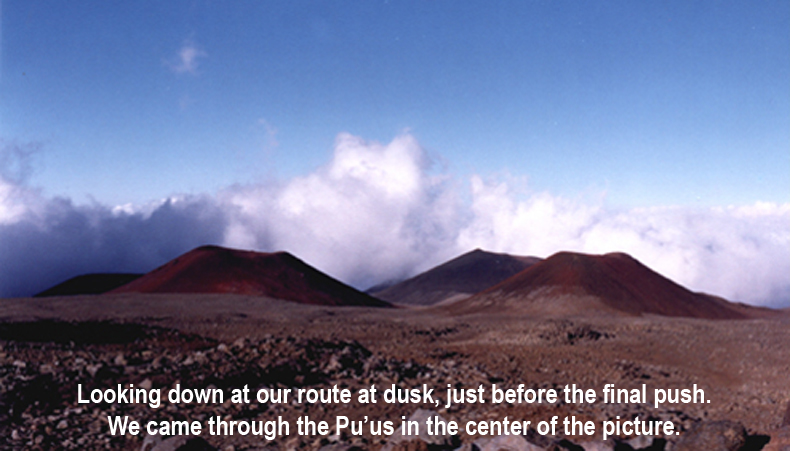 Well, almost nothing. Whatever it is that makes, say, a marathoner queasy after a big win, was operating here. Nature has a way of keeping things in balance, and the ignomnity of a couple dry heaves at the moment of triumph helps keep me from having any delusions of invincibility. (Jeff, on the other hand, may have that problem, since he doesn't evidence any frailty.)
Well, almost nothing. Whatever it is that makes, say, a marathoner queasy after a big win, was operating here. Nature has a way of keeping things in balance, and the ignomnity of a couple dry heaves at the moment of triumph helps keep me from having any delusions of invincibility. (Jeff, on the other hand, may have that problem, since he doesn't evidence any frailty.)
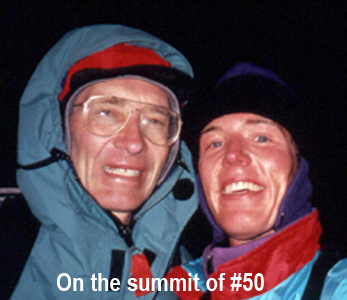 On the all-time list of finishers of the 50, this makes us (tied for) #13. Jeff also becomes the youngest person to climb all 50 highpoints (two weeks shy of age 22), and I become the first person to climb all 50 over the age of 50.
On the all-time list of finishers of the 50, this makes us (tied for) #13. Jeff also becomes the youngest person to climb all 50 highpoints (two weeks shy of age 22), and I become the first person to climb all 50 over the age of 50.